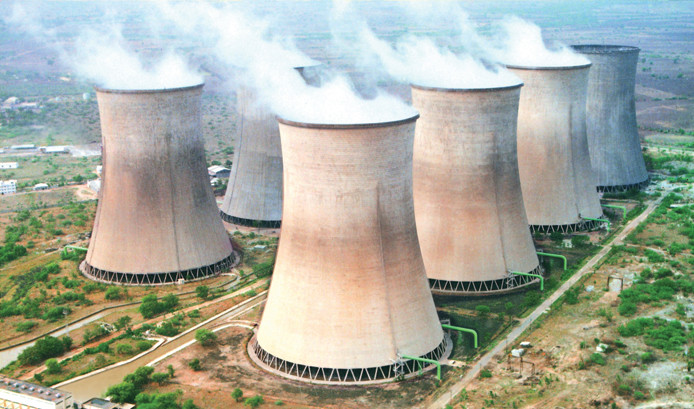Recent CNA Corporation research has brought to light new revelations about water consumption and the electricity sector–including that electricity generation could become difficult in areas of the world prone to water scarcity or water stress.
 “Given pending constraints in water availability, business as usual will be completely nonviable for the electric power industry,” Benjamin Sovacool, Professor of Business and Social Sciences at Aarhous University and Director of the Danish Center for Energy Technology at AU Herning, told The Speaker.
“Given pending constraints in water availability, business as usual will be completely nonviable for the electric power industry,” Benjamin Sovacool, Professor of Business and Social Sciences at Aarhous University and Director of the Danish Center for Energy Technology at AU Herning, told The Speaker.
The research findings, on which Sovacool worked, were published on the CNA Corporation website, and included two complimentary studies, “Capturing Synergies Between Water Conservation and Carbon Dioxide Emissions in the Power Sector” and “A Clash of Competing Necessities.”
CNA Corporation is a federally funded research and development center for the US Navy and Marine Corps. CNA Corporation also provides research and analysis for US national defense.
Read more: The Biggest Consumers of Water on the Planet are Not Measured for Water Use, New Study Discovers
“The electricity-water nexus makes ‘business as usual’ completely nonviable,” Sovacool told us, referring to the relationship between the amount of water used in energy generation and the among of energy used to distribute and treat the water. “Combined trends in population growth, increasing electricity consumption, and increasing water usage indicate that we cannot, and should not, continue to generate electricity the way we do today. Because water is an essential part of the cooling process for thermoelectric power plants, they may become wholly unsuitable as the globe enters a new era of accelerated water stress and water scarcity.”
According to CNA Corporation’s research, increasing water use will create water scarcity in 30-40 percent of the world by 2020, and will create a global water shortage by 2040. The resulting situation will be one in which decisions will have to be made whether to use water for energy generation plants–by far the largest consumers of water–or for human consumption.
Currently, power production operates with an assumption that there is no limit to water use. This “blind spot,” as CNA Corporation calls it, extends to policy and technology analysis–decisions about industry that involve water use by-and-large do not factor in water use.
Using a model with no water limits, power generation companies formulate graphs in which energy production is increased alongside an increased use of water–a less-than-realistic scenario, according to CNA Corporation’s research.
When actual water resources are accounted for, as well as more complex representations of water cooling, such as including carbon capture and storage/sequestration (CCS), graphs for future power production look very different.
CNA Corporation found that water consumption could be hundreds of percent larger than water limits.
“Including consideration of water availability in electricity planning fundamentally ‘changes the game’ of how we make future projections about power plants and capacity additions,” explained Sovacool.
This problem was found to exist globally. Although in the US the Energy Information Administration (EIA), which regulates the power sector, has recently been doing a better job of ensuring information recorded by power companies is correct, according to CNA Corporation, neither the EPA nor the Department of Energy (DOE) even have the authority to regulate water quantity–only quality.
According to the study’s principal author, Director of Energy, Water and Climate at the Institute for Public Research at CNA Corporation, Paul Faeth, “[T]he governing responsibility for energy and water are separated and fall into different ministries or departments which don’t communicate with one another.”
 “In the US, for example, the regulation of the power sector, which is the biggest source of water withdrawals in the US, falls to the US EPA but they do not have the authority to even consider the impact of their rules on water use,” Faeth told The Speaker. “Nor do they EPA or EIA have any models that account for water use.”
“In the US, for example, the regulation of the power sector, which is the biggest source of water withdrawals in the US, falls to the US EPA but they do not have the authority to even consider the impact of their rules on water use,” Faeth told The Speaker. “Nor do they EPA or EIA have any models that account for water use.”
However, the situation was even more bleak in the other countries CNA Corporation examined in their study. In France, India and China, the CNA Corporation team was unable to find any sources of water use data.
The revelations brought forth by the study have demonstrated the current global situation with regard to the changing nature of water resources.
“I suppose we weren’t really that surprised that most power plants do not report their water consumption, since this is not mandatory and most of the time water is free,” Sovacool told us. The research team recommended investment in wind and solar energy production.
“As we have shown, the electricity generation technologies that are beneficial for reducing greenhouse gas emissions correspond with those that require less water to operate, providing crucial benefits on both ends of the scale: reducing the inputs that contribute to the severity of climate change, avoiding additional stresses on water resources, and minimizing water use as climate change inevitably stresses water resources. Policies that promote renewables and efficiency thus provide multiple benefits beyond technical reliability and economic cost.”
By Day Blakely Donaldson

Please excuse typos and it should have read…300 tons of radioactive water entering the Pacific DAILY, for the past 3 1/2 years.
Add in the mix thermal pollution and routine releases of radionuclides….
http://www.beyondnuclear.org/storage/publications/Routine%20Releases%20from%20U.S.%20Nuclear%20Power%20Plants_November_2013.pdf
North Anna Power Station uses water from Lake Anna to condense steam back to water inside the station. The water is returned to the lake slightly warmer than when it was taken. The discharged water cools in a series of private cooling lagoons, known as the Waste Heat Treatment Facility (WHTF). When North Anna is in full operation, approximately 2,000,000 gallons of water pass through the station per minute.
https://www.dom.com/about/stations/nuclear/north-anna/waste-heat-treatment-facility.jsp
Nuclear power stations use huge amounts of water (North Anna’s 2 reactors use 2 million gallons a minute and discharge the water at at least 14 defrees hotter.
And if there is an accident, like the ongoing Fuskushima disaster….plus.there is about 300 tons of radioactive water entering the Pacific for the past 3 1/2 years….sigh.
We MUST invest in renewable energy NOW!